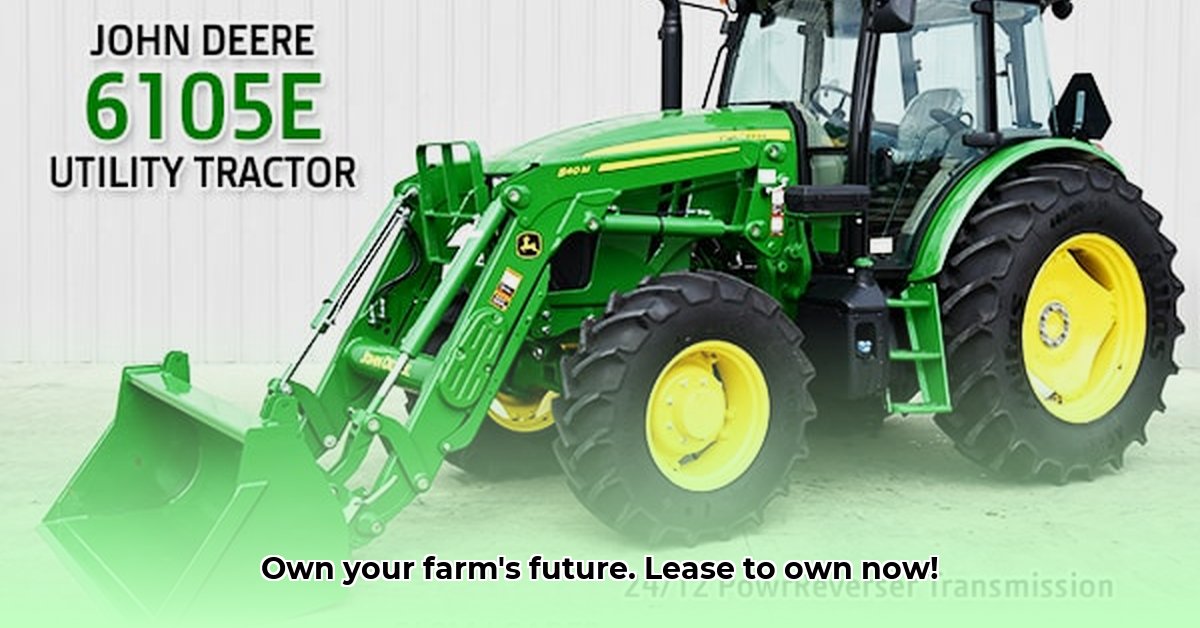
Weighing the Pros and Cons of Lease-to-Own for Sustainable Farming
Sustainable agriculture demands efficient, modern equipment, but the high upfront costs of new tractors can be prohibitive. Lease-to-own agreements offer a potential solution, allowing farmers to access advanced technology without immediate large capital outlays. However, understanding the advantages and disadvantages is crucial before committing. For more information on tractor leasing, see this helpful guide.
Advantages:
- Lower Initial Investment: Lease-to-own significantly reduces the initial financial burden, freeing up capital for other critical farm needs like seeds, fertilizer, or labor. This is particularly beneficial for smaller farms or those facing cash flow constraints.
- Access to Advanced Technology: Farmers gain access to the latest, more efficient and sustainable tractors, potentially improving yields and reducing environmental impact. This includes features like precision farming technology and fuel-efficient engines. Isn't maximizing efficiency a key goal for any sustainable operation?
- Predictable Cash Flow: Fixed monthly payments simplify budgeting and financial planning, creating greater stability for farm operations. This predictable cost structure helps in long-term financial management.
- Potential Tax Benefits: Depending on your location and tax laws, lease payments may be tax-deductible. Consult a tax professional to explore these possibilities.
- Easier Qualification: Securing a lease might be easier than obtaining a large loan, especially for farms with limited credit history.
Disadvantages:
- Higher Total Cost: While monthly payments appear lower, the total cost over the lease term often exceeds the price of outright purchase due to interest charges. Is the long-term cost justified by the benefits?
- Risk of Obsolescence: Rapid technological advancements mean that leased equipment might become outdated before the lease ends, potentially impacting efficiency and resale value. How can farmers mitigate this risk?
- Contractual Limitations: Lease agreements often include restrictions on modifications, usage, or early termination. Carefully review the terms and conditions to avoid unexpected penalties.
- Early Termination Penalties: Breaking the lease early typically incurs substantial financial penalties. Thorough planning and realistic assessment of your needs are crucial.
A Step-by-Step Guide for Farmers
- Needs Assessment: Determine your specific tractor requirements based on farm size, crop type, and tillage practices. Consider fuel efficiency, emissions, and any advanced features that align with your sustainable farming goals.
- Research and Comparison: Obtain quotes from multiple dealers and financing institutions. Compare not only monthly payments but also the total cost of ownership, including any maintenance or repair clauses within the lease. Remember that a lower monthly payment doesn't always equate to a better deal.
- Total Cost of Ownership (TCO) Analysis: Calculate the TCO for both lease-to-own and outright purchase, factoring in all costs: initial payment or lease payments, maintenance, repairs, fuel, potential early termination penalties, and the eventual resale or trade-in value. This comprehensive evaluation will guide your decision effectively.
- Contract Negotiation: Negotiate favorable terms, including maintenance agreements, purchase options at the end of the lease, and early termination clauses. Don't hesitate to ask questions and clarify any uncertain aspects of the contract.
- Risk Management: Assess the risks associated with technological obsolescence. Inquire about upgrade options or potential early termination clauses with minimized penalties.
A Step-by-Step Guide for Suppliers
- Competitive Lease Packages: Develop attractive lease programs that highlight the benefits of environmentally friendly equipment. Clearly outline terms and conditions, promoting transparency and trust.
- Sustainable Equipment Lifecycle: Design programs that incorporate environmentally responsible disposal or recycling of equipment at the lease's end. How will you maximize equipment lifespan and minimize waste?
- Transparent Contracts: Create clear, easy-to-understand contracts that protect both the supplier and the farmer. Consider using standardized contract templates recommended by agricultural organizations or government agencies.
A Step-by-Step Guide for Financial Institutions
- Specialized Risk Assessment: Develop risk assessment models specific to agricultural equipment leasing, considering factors like farm size, crop type, credit history, and the environmental sustainability of the equipment.
- Competitive Financing: Offer competitive interest rates and flexible repayment options to make lease-to-own more accessible to a wider range of farmers.
- Collaboration and Partnership: Work collaboratively with equipment suppliers and farmers to develop tailored financing solutions, accommodating individual needs and promoting sustainable practices.
A Step-by-Step Guide for Government Agencies
- Incentivize Sustainable Equipment: Offer tax incentives or grants to farmers leasing environmentally friendly tractors. Consider subsidies that are directly tied to measurable environmental benefits. Does the use of a specific tractor type directly influence environmental outputs? Consider research showing this connection.
- Support Research: Fund research into the long-term environmental and economic impacts of lease-to-own programs, informing policy decisions and improving the effectiveness of the model. Are there studies connecting lease-to-own to improved farm profitability?
- Standardize Contracts: Develop standardized lease contracts to ensure transparency, protect farmers' rights, and simplify the process for both parties.
Conclusion
Lease-to-own tractors offer a valuable pathway to sustainable farming practices. By carefully considering the advantages and disadvantages, and by thoughtfully engaging all stakeholders—farmers, suppliers, financial institutions, and government agencies—we can unlock the considerable potential of this financing approach to promote economically viable and environmentally responsible agriculture. The future of farming relies on collaboration, and lease-to-own agreements can be a key part of that future.